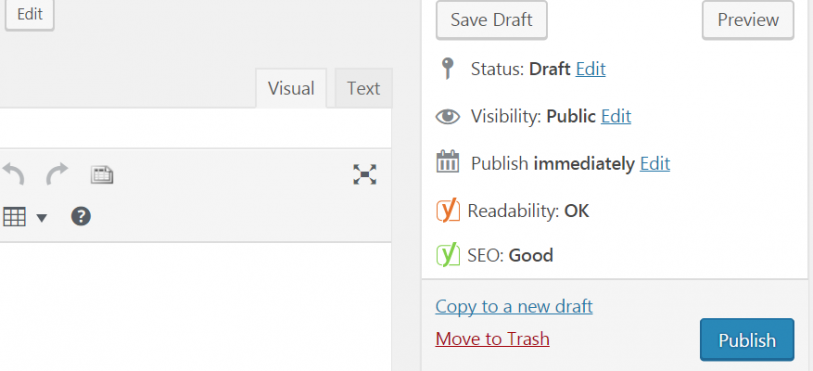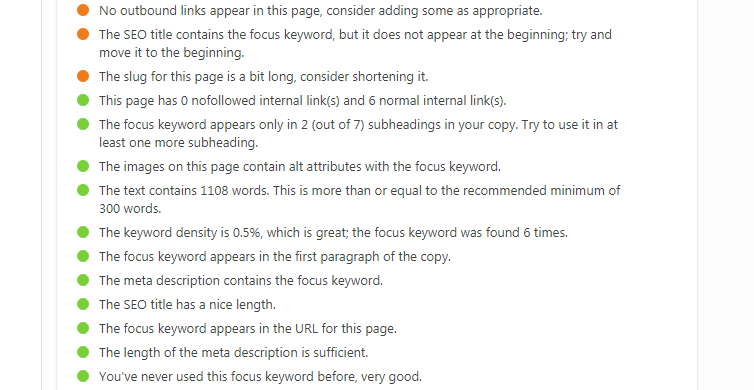
If you use WordPress, you’re likely familiar with Yoast SEO. One of the platform’s most popular plugins, Yoast analyzes content and provides insights on how it can be improved for SEO and readability. However, while it’s a useful tool, using Yoast can be a frustrating experience. If you’re like me, your initial encounters resulted in hours spent tweaking your content to gain the plugin’s approval, often to futile effect. At a certain point, you have to ask yourself, “Is it worth it?” I asked myself that very question, and the answer I found was…well, it’s complicated.
What does Yoast SEO do?
Before we get into assessing Yoast’s merits, let’s take a closer look at what it does. As we talked about in an earlier post, the aim of digital content should be to simultaneously appeal to both people and search engines. In a nutshell, that’s what Yoast wants to help you with. It does this by evaluating two major aspects of your content: search engine optimization and readability, each of which is assigned a tab on the plugin’s dashboard. Yoast’s evaluation is expressed as a row of color-coded bullets that correspond to various elements that make up that category. These bullets range from green (“Good”) to orange (“OK”) to red (“Needs Improvement”). Beside each is a short summary that affirms a satisfactory application or suggests improvements.
 On the SEO analysis tab, you’re prompted to enter your focus keyword(s) (the free version allots you one keyword while premium gives you up to five), after which Yoast evaluates your keyword application, paying special attention to keyword alignment and density. Yoast’s SEO analysis also checks the lengths of elements like SEO title, slug (the tail end of the URL) and meta description, as well as for the presence of internal and outbound links. However, due to the plugin’s emphasis on keywords, it’s possible to get a “Good” overall SEO score even if these latter parameters are wholly neglected.
On the SEO analysis tab, you’re prompted to enter your focus keyword(s) (the free version allots you one keyword while premium gives you up to five), after which Yoast evaluates your keyword application, paying special attention to keyword alignment and density. Yoast’s SEO analysis also checks the lengths of elements like SEO title, slug (the tail end of the URL) and meta description, as well as for the presence of internal and outbound links. However, due to the plugin’s emphasis on keywords, it’s possible to get a “Good” overall SEO score even if these latter parameters are wholly neglected.
Clicking over to the readability tab, you’ll see that Yoast’s analysis relies on several parameters, including sentence and paragraph length, incidence of passive voice and transitional words, and, most notably, “ease of reading.” The latter parameter is notable because it’s determined using the “Flesch Reading Ease test,” which also happens to be the hardest thing to score well for. This is regardless of one’s writing ability: since the Flesch test equates readability not with how well-written a text is but how easy it is to read, even a scholarly essay can receive a low score. That’s why even a seasoned blogger is likely to see red—both literally and figuratively—when viewing their Flesch test score.
Does Yoast SEO work?
The biggest misconception about Yoast is that it directly corresponds to reality; that is, if a post gets the Yoast greenlight, it’ll consequently break the Internet. That’s what keeps novices (like myself, until recently) glued to their screens, tinkering with their keyword phrases to turn those red bullets green. What they fail to realize is that Yoast is merely a template—it doesn’t necessarily translate to actual performance. After all, the success of a given post is determined by a lot more than keywords and readability, including search query relevance and domain authority—two things you can’t get from a plugin.
In a word, Yoast’s suggestions won’t get you to your destination, but they can nudge you in the right direction. Once you understand this, you can start working toward a healthier, less codependent relationship with Yoast.
Fostering a healthy relationship with Yoast
As many know firsthand, a relationship with Yoast can be somewhat dichotomous (read: love/hate). Maybe that’s because Yoast is a lot like a parent with overly high expectations—the kind who asks why you got an A- instead of an A (or, in this case, why you only included your focus keyword in four of your five subheadings). On one hand, this can motivate you to improve your writing and your application of SEO; on the other hand, it can hurt your confidence and cause you to stress out over miniscule things. That’s why, if you’re going to use Yoast, you need to look at your relationship and make sure there’s a healthy dynamic.
In my case, my relationship with Yoast improved after I came to recognize it for what it is: a useful tool, if flawed in its attempts to quantify the unquantifiable. After all, Yoast is essentially a robot, and last time I checked, robots aren’t the most qualified judges of textual nuance or emotion. That’s why Yoast’s suggestions are best regarded as guidelines, not gospel. So, don’t put all your chips on green; instead, seek to strike a balance between Yoast’s criteria and your own artistic standards.
In the course of making my peace with Yoast, I’ve identified a few of its key advantages, as well as a few potential disadvantages.
Advantages of Yoast SEO
It ensures the basics are in place. SEO comprises several different components, and it can be hard to remember them all. Yoast’s most helpful attribute is that it checks all of these for you so you don’t forget to write a meta description or include your target keyword in an image’s alt text.
It lets you put your learning into practice. If you’re new to SEO, Yoast can be a helpful vehicle for implementing your newly acquired knowledge. Just think of it as a pair of SEO training wheels.
It can improve your writing. After your writing has repeatedly been subjected to Yoast’s critique, you’ll start to be more aware of things like sentence length and passive voice. Over time, this will become manifest in your writing, which will be tighter, better organized and more direct.
Potential disadvantages of Yoast SEO
It can result in a lot of wasted time. While it can be a fun challenge to max out your green bullets, at a certain point you’re just spinning your wheels. Modifying subheadings, shortening sentences, squeezing in another instance of your keyword—you can spend hours on this stuff. However, in practice, nine green bullets are virtually indistinguishable from eight greens and one orange, so you’re better off investing your time toward something more useful, like punching up your prose.
It can cause you to focus on the wrong things. For example, Yoast always recommends putting your focus keyword at the front of your post title. However, if you already have a great title, this is bad advice. When it comes to attracting readers, an interesting title that doesn’t start with a keyword will fare better than a boring one that does.
Another example is keyword density. Yoast recommends a keyword density of 0.5 to 2.5 percent, but just how important is this? If you do a little research, you’ll find most SEO authorities say something along the lines of, “It’s important, but…” and go on to emphasize the greater significance of content quality. So, don’t get sidetracked by the small stuff—you should be more focused on creating great content than perfecting your keyword alignment.
It can hurt your writing. Wait, didn’t I just say it can improve your writing? Well, that depends. Consider this excerpt from Yoast’s article about the Flesch test:
“Texts with a very high Flesch reading ease score (about 100) are very easy to read. They have short sentences and no words of more than two syllables.”
Translation: The more you dumb down your writing, the better score you’ll get. Sound bogus? I thought so, too. If quality content is king (and it is), there’s a lot more to composing a piece than making it digestible for an 11-year old. By trying too hard to ace the Flesch test, you could wind up losing your audience—unless, of course, you’re writing specifically for 6th graders.
So, is Yoast worth bothering with? To ape the tentative tone of those SEO authorities, “Yes, but…”
Want to learn more about SEO basics for your business website? Check out our SEO for SMBs series.
Need help building a website? Contact us!
